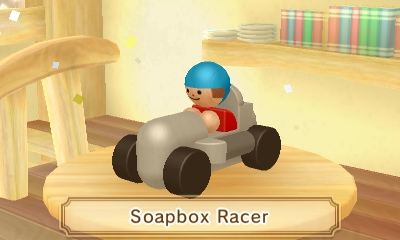My name is Tanner Hendrickson, and I am a Picross 3D: Round 2 addict. I freely admit that I have a problem. After tirelessly campaigning for a release outside of Japan, Nintendo of America acquiesced and gave puzzle fans in the Americas (and soon, Europe) the best reason to own a Nintendo console since, well, the original Picross 3D. It was scary there for a while, but we did it. And boy, was it worth the wait.
Picross 3D is similar to its two-dimensional namesake in that you use numerical hints to deduce the proper locations of boxes, eventually revealing a recognizable image. The transition to the third dimension necessitated a change in mechanics to keep the experience from getting obnoxiously fiddly to play. Instead of trying to place blocks in 3D space, you instead remove blocks from a much larger block. Where Picross is paint-by-numbers, Picross 3D is marble-sclupture-by-numbers. I’m a huge fan of traditional Picross, but there’s something about creating through destruction in Picross 3D that’s even more satisfying to me.
Picross 3D: Round 2 advances the formula established in the first release by introducing a second block type into the mix. Now blocks are either blue or yellow. Blue blocks are regular cubes, but yellow blocks turn into more complex shapes once their row or column is completed. The immediate result of this new mechanic is that the finished models can be much more complex than in the first game. But beyond the surface effects, it adds a whole new deductive layer to the game.

You now have to not only deduce which blocks remain, but also which color they are. The process of solving a puzzle changes significantly, which is something I was not expecting. I would’ve been perfectly fine with just “More Picross 3D”, but Picross 3D: Round 2 managed to far surpass my expectations with this new twist.
I was expecting to breeze through Round 2 even on the hard setting, having completed the original game about two and a half times. The dual-color system was a rug pull in the best way, forcing me to change my approach and learn new strategies. Puzzles now take significantly more time and brain power to solve, especially when trying to minimize mistakes. The one downside to this new addition is that the tool count ballooned from two to five to accommodate it. Most of the mistakes I made were the result of forgetting which tool I was selecting, but this shouldn’t be as big of an issue for newcomers to the series.
As with nearly every Nintendo/HAL production, the level of polish is unmatched. The barely-there framing device for the game is a sort of puzzle cafe (Oh, how I long to go there!) that is seen in the background of the main menus and the puzzle results screen. The finished puzzles become little wooden figurines that get displayed on the upper screen of the main menu in random assortments. Every puzzle also has adorably quaint flavor text, which is especially nice to have for the puzzles that are specific to Japanese culture. Also, the sound design on the puzzles is amazing. The painting and brick-breaking sound effects are as addictive and satisfying as popping a sheet of bubble wrap.
All of this adds up to create the most addictive puzzle game I’ve ever played. I’m not exaggerating when I say that I played fifty hours in the first two weeks of Round 2’s release. Towards the end of that period, I hit what I thought to be the end of the game. I thought I was finally free but, no. After the credits rolled, an entirely new set of puzzles unlocked. I think it might be the meanest thing a game has ever done to me. Or the nicest. It’s the kind of game where I don’t know whether to give a recommendation or a warning. If you have a 3DS and enjoy puzzles at all, you should absolutely buy this game. Just keep the methadone handy.



Nice review, Tanner! I’m the same as you, I can’t get enough of Picross games.
I don’t know if you tried this or not, but when I need to pull 3DS screenshots, I use Miiverse to take the screens, then log in from my computer and save the images. Roundabout, I know, but it works.
Thanks, Shaun! That’s actually how I got the screen of the soapbox racer. I just wasn’t happy with how it looked with our default image set-up here, what with the low resolution of the 3DS and Miiverse’s compression. I follow an Animal Crossing tumblr that uses smooth-scaling for screenshots to make them look not like butt, so I might look into that if I end up covering another 3DS game.